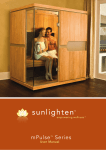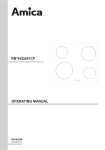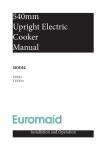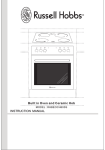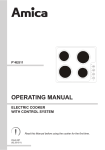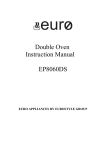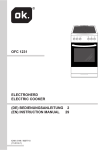Download Amica PBP4VQ242 Technical data
Transcript
OPERATING MANUAL CERAMIC PLATE WITH TOUCH CONTROL PG4VQ242 PBP4VQ242 DEAR USER, • • • • • • The Operating Manual has been compiled so that you may quickly yet thoroughly familiarise yourself with your new ceramic plate. Before using your ceramic plate for the first time, read this Operating Manual thoroughly and carefully. Familiarise yourself with your new appliance and its respective operating functions as they appear in the Manual. Observe all instructions and suggestions concerning proper use and maintenance of your plate as only thus can you ensure continuous readiness to work and long life for your appliance. Pay special attention to safety instructions. Try to avoid accidents and protect your plate against damage. Keep this Manual close at hand for further consultation. Caution! Operate the appliance only after reading / understanding this Manual. The appliance has been designed only for cooking. Any other use (for example for heating) does not comply with its operating profile and may cause danger. The producer reserves a right to implement changes having no impact on the operation of the appliance. 2 TABLE OF CONTENTS Basic information.................................................................................................2 Safety instructions................................................................................................4 Saving energy.......................................................................................................5 Unpacking...............................................................................................................6 Disposing of the device........................................................................................6 Description of the appliance...............................................................................7,9 Installation ...........................................................................................................8 ,10 Connecting the plate to the electrical system .........................................................11 Guidelines for the installer ....................................................................................11 Operation ..........................................................................................................12 Before first use of cooking plate...........................................................................12 Proper cookware .................................................................................................13 Control panel ......................................................................................................14 Switching on the ceramic plate ...........................................................................14 Switching on a hotplate .......................................................................................14 Setting up the heating power ...............................................................................15 Automatic power reduction system ......................................................................15 Switching off the whole ceramic plate .................................................................16 Switching off a hotplate ......................................................................................16 Lock function ......................................................................................................16 Locking the plate ................................................................................................16 Unlocking the plate .............................................................................................16 Residual temperature indicator ...........................................................................17 Limited time of operation ....................................................................................17 Cleaning and maintenance ...............................................................................18 Emergency procedures......................................................................................20 Technical data ....................................................................................................22 Warranty and customer service ........................................................................23 3 SAFETY INSTRUCTIONS 4 Before using the ceramic plate for the first time read the Operating Manual carefully as thus you can ensure safe operation and avoid damage to the plate. If the ceramic plate is operated near a radio, TV set or other emitting device, please check whether the touch panel works correctly. The ceramic plate should be installed by a qualified electrician. Do not install the plate near refrigerating devices. The furniture the plate is fitted in should be resistant to temperatures up to 100ºC. The requirement applies to the veneers, edges, plastic surfaces, glues and varnishes. The plate can be used only after it has been fitted into furniture, as only thus you will be protected from accidental contact with live components. Electric appliances can be repaired only by qualified specialists. Unprofessional repairs may compromise the safety of the appliance. The appliance is disconnected from the mains only when the mains plug is pulled out from the socket or when the fuse has been switched off. Do not allow children to come near the plate when in operation, as they can push the hot pots down and get burnt. When switched on the hotplates quickly become hot. To avoid unnecessary power consumption, switch them on only after putting a cooking pot. Residual temperature indicator built-in into the electronic system tells you whether the hotplate is still switched on and whether it is still hot. Should there be a power failure, all the settings and indications will be cancelled. Please be careful when the power supply is restored as hotplates which have been hot before power failure will no longer be controlled by the indicator. If there is a mains socket located near the hotplate, please make sure that the supply cord does not touch the hot places. Do not leave the plate unattended when cooking on fats and oils as they create fire hazard. Do not use plastic pots or containers made from aluminium foil as they melt in high temperatures and may damage the ceramic plate. Sugar, citric acid, salt etc., both in liquid and solid state, as well as plastic should not get into contact with a hot hotplate. If through carelessness, sugar or plastic gets on a hot hotplate, you may not switch off the plate but scrape away sugar or plastic using a sharp scrapper. Protect hands from burns. Use only flat-bottom pots and saucepans on your ceramic plate, without sharp edges or burrs as otherwise the plate may get permanently damaged. The heating surface of the ceramic plate is resistant to thermal shock. It is neither hot nor cold-sensitive. Avoid dropping objects on the plate. A point hit, for example a falling bottle with spices, may in unfavourable circumstances lead to cracks and splits appearing on your ceramic plate. SAFETY INSTRUCTIONS Boiled over residuals of food may penetrate damaged places and get to the live components of the ceramic plate Should cracks or splits appear on the surface of your ceramic plate immediately disconnect it from the mains. In order to do so, switch off the fuse or pull out the mains plug from the socket. Call the Customer Service Please observe the maintenance and cleaning guidelines. Should you fail to proceed in compliance with the provided guidelines, you will lose your warranty rights SAVING ENERGY Everybody who properly uses energy not only saves money but also consciously acts in aid of the natural environment. So let’s save electric energy by: Using proper cookware Pots and pans with flat and thick bottom help to save up to one-third of electric energy. Remember about the lid as otherwise the consumption of energy quadruples! Timely switching off hotplates and using the residual heat When cooking for a long time, switch off the hotplate 5 to 10 minutes before the end of cooking as thus you can save up to 20% of electric energy. Not using the plate near refrigerators / freezers As the consumption of energy unnecessary rises. Matching cookware to the size of the hotplate A cooking pot should neither be smaller nor bigger than the used hotplate. Maintaining hotplates and pot bottoms clean Dirt obstructs the transfer of heat – heavily burnt food residuals often can be cleaned only with chemicals harmful to the environment. Avoiding necessary “peeping into pots”. 5 UNPACKING The appliance is protected from damage during transportation by its packaging. After unpacking please dispose of the packing materials in a manner creating no risk to the environment. All materials used for packing are harmless to the natural environment, can be recycled in 100% and have been identified with appropriate symbol. Caution! Packing materials (polyethylene bags, pieces of polystyrene etc.) should be kept away from children during unpacking. 6 DISPOSING OF THE DEVICE When disposing of the device, do not bring it to regular municipal waste containers. Instead, bring it to electrical and electronic waste recycling and reuse center. A relevant label has been put on the device, its instructions manual, or on the package. The device has been manufactured of recyclable materials. By bringing old device to recycling collection center, you show that you care about nature. Ask your local environmental care authority for information on location of such facilities. DESCRIPTION OF THE APPLIANCE Description of PBP4VQ242 plate Hotplate – rear left 145 Hotplate – rear right 180 Hotplate – front left 210 Hotplate – front right 145 Control panel 3 2 2 Main sensor Hotplate selection sensor Hotplate indicators Minus sensor Plus sensor Lock sensor with LED signalling diode 5 4 1 1. 2. 3. 4. 5. 7. 7 7 INSTALLATION Installation of PBP4VQ242 plate prepare a place (an opening) in the table top according to dimensions specified on the installation drawing (Fig. A) minimal clearance to be left between the bottom furniture enclosure and the rack is 80 mm connect the plate to the mains according to the attached wiring diagram match the section of the mains cable to the power of the plate (should be done by a qualified electrician) unstick paper protecting the double-sided adhesive tape stuck on one side to the edge of the plate remove dust from the top, insert the plate into the opening and press hard fill the gap between the top and glass with silicone (Fig. B) Fig. A 581 50 48 6 60 0 3 51 544 Fig. B 1 2 3 4 1 - table top 2 - silicone 3 - double-sided adhesive tape 4 - ceramic plate 8 DESCRIPTION OF THE APPLIANCE Description of PG4VQ242 plate Hotplate – rear left 145 Hotplate – rear right 180 Hotplate – front left 210 Hotplate – front right 145 Control panel 3 2 2 Main sensor Hotplate selection sensor Hotplate indicators Minus sensor Plus sensor Lock sensor with LED signalling diode 5 4 1 1. 2. 3. 4. 5. 7. 7 9 INSTALLATION Installation of PG4VQ242 plate prepare the place (the opening) in the table top of the piece of furniture according to the assembly sketch, the minimum space to be provided free under the ceramic plate is 80 mm, connect the stove to the electric power supply network in compliance with the operating manual of the stove, screw on lightly the holders underneath the ceramic plate, clean the table top from the dust, put the ceramic plate into the opening and press it strongly to the table top, place fastening holders (Fig. B) perpendicularly to the stove edge and screw them home, fill the gap between the stove and the table top with a silicone material. Fig. A +1 483 50 600 45 50 5 575 40 40 555 (min) (min) Fig. B Seal Ceramic Hob Worktop Bracket 10 Screw INSTALLATION Connecting the plate to the electrical system Note! The plate can be connected to the mains only by a qualified certified installer. Wilful adaptations or modifications to the electric system are prohibited. Guidelines for the installer The plate is factory-set for three-phase alternating current power supply (400 V 3N~50 Hz). It may be adapted for one-phase current power supply (230 V) by adequate bridging on the connection strip, in accordance with the attached wiring diagram. The wiring diagram is also provided in the bottom part of the lower cover. The connection strip can be accessed once the lid on the bottom cover is removed. Please remember to match the mains connection cable to the type of connection and the rated power of the plate. Fix the mains connection cable in a stay wire Note! Do not forget to connect the protective circuit to a clamp of the connection strip marked with sign. The plate power supply system should be protected by appropriately selected safety device or after the power supply protection, by appropriate safety switch cutting off the power in case of emergency. Before connecting the plate to the electric system read information provided on the rating plate and wiring diagram. Note! The installer is obliged to complete and leave with the user a “certificate of connecting the plate to the mains” (attached to the warranty card). Methods of connection other than those indicated on the diagram can damage the plate. 11 INSTALLATION DIAGRAM OF POSSIBLE CONNECTIONS Warning! Heating elements voltage - 230V Warning! In every type of connection protective grounding has to be connected to PE terminal 1 Mains 230V one phase connection with neutral conductor, bridged terminals 1-2-3 and 4-5. Protecting grounding on 1/N~ 2 Mains 400/230V two phase connection with neural conductor, bridged terminals 2-3 and 4-5. Protecting grounding on 2/N~ 3 Mains 400/230V three phase con- 3/Nnection with neutral conductor, bridged terminals 4-5, phases 1, 2 and 3, zero on 4-5. Protecting grounding on ~ 1 2 3 4 N L1 1 2 3 2 4 PE 5 N L1 L2 1 5 3 L1 L2 L3 4 PE 5 N PE Recommended type of connector cable H05VV-F3G4 H05VV-F4G2,5 H05VV-F5G1,5 L1=R, L2=S, L3=T, N=neutral conductor terminal, PE=protecting grounding OPERATION Before first use carefully clean the ceramic plate treating it as a glass surface when used for the first time the plate can give off a bit of a smell so switch on the ventilation system or open the window operate the plate observing the safety instructions 12 OPERATION The ceramic plate is equipped with sensors operated by touching the marked areas with a finger. Every touch of a sensor is confirmed with a sound. When switching the plate on and off and setting the heating power always touch only one sensor. If you touch several sensors at the same time (with the exception of switching off the hotplate or the clock), the system will ignore the entered settings and, should you keep touching the sensors for a long time, will emit a fault signal. Proper cookware There is specially made and tested cookware for cooking on ceramic plates availabl on the market. Observe instructions provided by the cookware manufacturers. Cookware with aluminium or copper bottoms can leave metallic discoloration, very difficult to remove. Be particularly careful when using enamelware, as it may irreparably damage your plate when left on a hotplate with the content boiled down. To achieve optimal power consumption, optimal cooking times and to avoid burning of food boiled over on the plate, observe the following recommendations. Bottoms: The cookware should have a stable, flat bottom, as sharp-edged bottoms or bottoms with burrs and charred food residuals can scratch your ceramic plate and have abrasive impact on it! Sizes: The diameter of the bottom surface of the pot should match the diameter of the used heating element. Lids: Lids prevent heat from escaping from the pot and thus shorten the cooking time and reduce the consumption of power. 13 OPERATION Control panel Upon connecting the plate to the mains a short sound should be emitted, after which you can operate the plate! Caution! Do not put any objects on the area of the sensors (a fault can be trigged), always keep them clean. Switching on the ceramic plate If the plate is not in operation, all the hotplates are switched off and the display is blank. When you touch the main sensor (1), the plate switches on and all the hotplate indicators (3) show “0” for about 10 seconds. You can now set the required heating power by touching sensors “+” (5) or “-“ (4) having previously selected a hotplate by touching sensor (2) (see Setting up the heating power). Should you fail to activate any sensor within 10 seconds, the plate will switch off automatically If the children lock is active the plate cannot be switched on (see Unlocking the plate). Switching on a hotplate After switching on the plate with the main sensor (1) the individual hotplates are set in the following manner: 1. Select the desired hotplate with appropriate hotplate selection sensor (2). The assignment of sensors to the respective hotplates corresponds with the hotplates’ layout. 2. Set the required heating power by touching sensors „+” (5) or „-”(4). 3. To change the set heating power, proceed as in point 1, so first select the desired hotplate with appropriate hotplate selection sensor (2) and then adjust the heating power with „+” (5) or „-” (4) sensors Should you fail to activate any sensor within 10 seconds from switching on the plate, the hotplate will switch off . A hotplate is active when the indicated figure flashes, meaning that the hotplate is ready to set the heating power. 14 OPERATION Setting up the heating power To set the required heating power first you have to select a hotplate with sensor (2). As long as digit “0“ is flashing on the indicator (3), you may set the required heating power with „+” (5) or „-” (4) sensors. If you do not wish to use the automatic power reduction system, start setting the heating power from „+” sensor (5). You may then increase the heating power with „+” sensor (5) or reduce it with „-” sensor (4). If you wish to use the automatic power reduction system, start setting the heating power from „-” sensor (4). (See Automatic power reduction system). Heating power level 1 2 3 4 5 6 7 8 9 Quick cooking time (min) 1 3 4,8 6,5 8,5 2,5 3,5 4,5 - Automatic power reduction system Every hotplate is provided with automatic power reduction system. If the system is activated, the hotplate will be switched on at its full power for a time depending on the selected heating power level and then the power will be switched to the set heating power level. The automatic power reduction system will be activated if you start setting the heating power from „-” sensor (4). The hotplate indicator (3) displays the heating power level “9”. When you touch “+” sensor (5), the hotplate indicator (3) will display a dot near “9” digit for about 10 seconds. If, within 10 seconds, you start setting the heating power with „-” sensor (4), the automatic power reduction system will be activated and “A” letter will be displayed, flashing by turns with the heating power level selected for the respective hotplate. You can now adjust the heating power following instructions given in the chapter: „Setting up the heating power” If you do not start setting the heating power within 10 seconds, the dot near digit “9“ will disappear, letter “A“ will not be lighted and the automatic power reduction system will stay inactive. If you do not wish to use the automatic power reduction system, start setting the heating power from „+” sensor (5). You can now adjust the heating power following instructions specified in the chapter: „Setting up the heating power”. 15 OPERATION Switching off the whole ceramic plate The plate is in operation as long as at least one hotplate is switched on. You can switch off the whole plate by touching the main sensor (1). The hotplate indicator (3) displays letter “H”, indicating the residual temperature. Switching off a hotplate You can switch off one of the hotplates proceeding as follows: 1. Select the hotplate you wish to switch off with the hotplate selection sensor (2). 2. Touch sensors „+” (5) and „-” (4) at the same time or reduce the set point to “0” using sensor „-” (4). Letter “H” is displayed indicating the residual temperature. Lock function The lock function, activated by the key sensor (7), prevents the activated hotplate from being accidentally switched off by children, pets etc. If you lock the plate when all the hotplates are switched off, the plate will be protected from unintentional activation and can be operated only when unlocked. If the lock function (7) is active and hotplates are switched on you can switch off the plate be keeping sensors (2) or (4) or (5) for about 5 seconds. After power failure the lock is activated automatically. Locking the plate To lock the plate touch the key sensor (7) until the LED (7) is lighted. At the beginning of touching a short signal is emitted. Unlocking the plate To unlock the plate touch the key sensor (7) until the LED (7) goes out. At the end of touching a short signal is emitted. 16 OPERATION Residual temperature indicator When a hot plate has been switched off, letter “H” is displayed indicating that the hotplate is still hot. Do not touch the hotplate and do not put heat-sensitive objects on it when the “H” letter is displayed as you can burn yourself or melt the object! When the indication goes out you can touch the hotplate, bearing in mind that it still does not have ambient temperature. After power failure the residual temperature indicator is no longer active. Limited time of operation To increase reliability of the plate each hotplate is provided with operation time limiter. The maximal time of operation depends on the last selected heating power level. If the heating power is not changed during the specified time (see the Table), the hotplate will be switched off automatically and the residual temperature indicator will be lighted. If you want to continue cooking, switch on the hotplate again at the required level of heating power. Heating power Maximal time of operation in hours level 1 2 3 4 5 6 7 8 9 10 5 5 4 3 2 2 2 1 17 CLEANING AND ROUTINE MAINTENANCE Daily cleaning and proper maintenance have crucial impact on the durability of your ceramic plate. Clean the ceramic plate observing the same rules as for glass. Never use abrasive or aggressive cleaning agents, scrubbing powders or scratching sponges. Cleaning the plate after every use Wipe off slight, not-burnt patches of dirt using damp cloth without cleaning agent. Washing liquid can cause blue discoloration to appear on the plate. The stubborn stains often cannot be removed after first cleaning, even if special cleaning agents are used. Remove larger patches of dirt, strongly sticking to the plate using sharp scrapper and wipe off the surface with a damp cloth. Removal of stains Light pearly stains (aluminium residues) can be removed from cooled plate using special cleaning agents. Calcareous residues (i.e. boiled over water) can be removed with vinegar or special cleaning agents Do not switch off the hotplate when removing sugar, sugar-containing food, plastic or aluminium foil! Immediately scrape off the residuals (when still hot) from the hotplate using a sharp scrapper. When the dirt is removed you can switch off the plate and clean it again after cooling down using special cleaning agents Special cleaning agents can be bought in supermarkets, special electromechanical shops, drugstores and shops with kitchen appliances. Sharp scrappers can be bought in DIY shops, shops with building tools and painting accessories. Cleaning scrapper 18 CLEANING AND ROUTINE MAINTENANCE Never apply cleaning agent on a hot hotplate. Leave the cleaning agent to dry and then wipe it off with a wet cloth. Any residuals of cleaning agents should be wiped off with a damp cloth before heating the plate for the next time, as otherwise they can have caustic effect. Failure to observe the ceramic plate maintenance instructions can result in losing your warranty rights! Caution! If from any reason you are not able to control the switched on plate, switch off the main switch or screw out the fuse and call the Customer Service. Caution! Should cracks or splits appear on the surface of your ceramic plate, immediately disconnect the plate from the mains (by switching off the fuse or unplugging the plug) and call the Customer Service. 19 EMERGENCY PROCEDURES Every time when emergency situation occurs you should: • switch off the working assemblies of the plate • disconnect power supply • call in the service • as some minor faults can be removed by the user in accordance with the below specified instructions, before calling the Customer Service please go through the Table checking every point. PROBLEM CAUSE ACTION 1.The appliance is not wor- - Power supply failure king - Check the in-house fuse, replace if necessary 2. The appliance does not respond to entered settings - Switch it on - Control panel has not been switched on - Sensors have been touched for less than one second - Several sensors have been touched at the same time - Touch the sensors for a bit longer - Always touch only one sensor (except when switching off a hotplate) 3.The appliance does not - Children lock has been - Switch off the children lock respond and emits a short activated signal 4.The appliance does not respond and emits a long signal - Improper operation (improper - Again activate the plate sensors have been touched or proper sensors have been touched for too short time - Covered or dirty sensor (sen- Uncover or clean the sensors sors) 5.The whole appliance swit- - No settings have been enches off tered within 10 seconds from switching the plate on - Covered or dirty sensor (sensors) 6.One hotplate switches off 20 - Again switch on the control panel and immediately enter the settings - Uncover or clean the sensors - Again switch on the hotplate - Covered or dirty sensor - Uncover or clean the sensors (sensors) - Limited time of operation EMERGENCY PROCEDURES PROBLEM CAUSE ACTION 7.Residual temperature indica- - Power supply failure, the -The residual temperature tor is not lighted although the appliance has been discon- indicator will work again after switching the control panel nected from the mains hotplates are still hot on and off. 8. Crack in the ceramic plate 9. If the fault still remains Danger! Immediately disconnect the ceramic plate from the mains (fuse) and call the nearest Customer Service Centre. Disconnect the ceramic plate from the mains (fuse) and call the nearest Customer Service Centre. Important! You are the person responsible for proper condition and operation of the appliance in your household. If you call the Service due to a fault which resulted from improper operation, you will be charged with the costs of the visit even during the period of warranty. We shall not be held liable for damages caused by a failure to observe this Manual. 21 TECHNICAL DATA Rated voltage Rated power 3N 400V ~50 Hz Dimensions Weight 581 x 513 x 48; 575 x 505 x 48; ca.8 kg 22 - hotplate : 145 mm - hotplate : 180 mm - hotplate : 210 mm - hotplate : 145 mm 1200 W 1800 W 2300 W 1200 W WARRANTY AND POST-SALE SERVICES Warranty Warranty services according to the warranty card. The producer shall not be held liable for any damages caused by improper operation of the product. Please enter the type and factory number of the plate from the rating plate Type...................................... Factory number...................................... 23 IOAA-232 (05.2007/1)
























